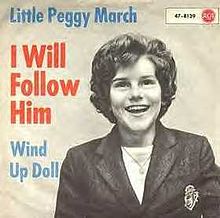Anticipating and hoping for something for a month is difficult at best but even more so if you have just turned 15 years old. Such was the situation that Peggy March found herself in during April of 1963 as her song “I William Follow Him” spent a month in the number two position on the Billboard Magazine Hot 100.
Little Peggy March, as she was known at the time, was 15 years, one month, and 13 days old when “I Will Follow Him” finally reached number one April, 27, 1963. It made her the youngest female to ever have a number one pop hit beating out Brenda Lee by about six months.
Peggy March was discovered singing at a family friend’s wedding. Several weeks later she passed an audition for RCA records. Her first single release, “Little Me,” was a flop but her second release was the biggest hit of her career. When you combine its three weeks at number one and five at number two, it was one of the biggest hits of 1963. It also topped the Rhythm & Blues Chart for one week, which was a real stretch as it was a pure pop song.
It was originally a French song written by Paul Mauriat and Frank Pourcel under the assumed names of Del Roma and J. W. Stole. Record by Petula Clark in 1962, it reached the top of the French pop chart that same year.
The Americanized version of “I Will Follow Him” was a smooth mid-tempo pop song that was representative of what was being released in the 1960s pre-Beatles era. March had a booming voice and pure voice that made the song one of the more memorable of the era.
She would record for the RCA label until 1971 but only four more singles would make the Hot 100 and none would enter the top 20. She would spend the 1970s as a German superstar. Living in the country, she would place 26 singles on their pop chart.
She moved back to the United States during the early 1980s and continues to perform and write songs. Despite the lack of commercial success for the last three decades, she can look back to 50 years ago this week when she ruled the American music world.




 Posted by David Bowling
Posted by David Bowling 




